by Jon Anderson
CandysDirt.com
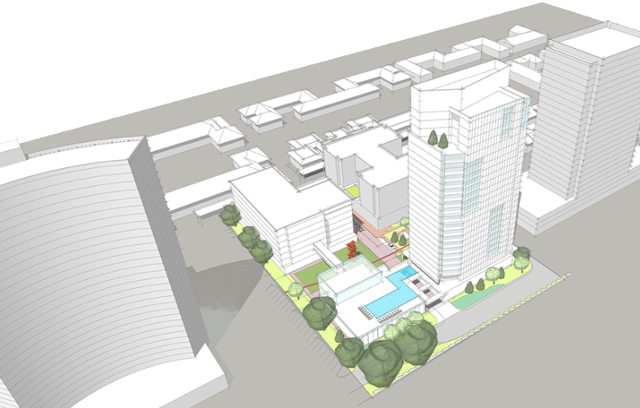
Will the city stop playing politics and do what’s right to help the Pink Wall’s PD-15 get the update it deserves?
Beginning in April 2018, city staff ran the Authorized Hearing process working with the Pink Wall’s PD-15 committee. The Authorized Hearing process, whereby the city oversees a community response to zoning changes, was kicked off because the original 2017 neighborhood committee stalemated. That stalemate can be blamed on the intractable NIMBYism of the Athena and Preston Tower (catch-up on last meeting here). The Authorized Hearing ended in a similar stalemate. At that point, November 2018, city staff was asked by council member Jennifer Gates to write the changes they’d propose to make to update the decades-old PD-15.
Of course, the “N” in NIMBY stands for “Not” and that pretty much summed up the towers’ response.
But at least a semblance of a plan was on paper, something two committees had failed to get anywhere near in two years. While I had my own beefs with it (various spacing and setback tweaks), at least there was something to work with – a far cry from the towers’ fantasyland that reached its zenith in a nasty city council race, pitting incumbent Jennifer Staubach Gates against former Mayor Laura Miller, who was backed by activists at Preston Tower and The Athena.
It was city staff’s recommendations that made it to City Plan Commission in a two-part session in April and June. While city staff and city plan commissioners were pre-briefed, the public’s applecart was upset by a last-minute plan put forth by Provident Residential for the Preston Place and Royal Orleans lots at the June Plan Commission meeting. It called for blowing the 240-foot height limit on Northwest Highway in exchange for lower lot coverage, which would transform the neighborhood with green space.
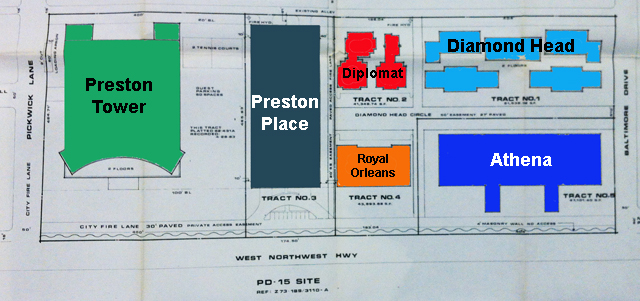
PD-15 Map
Provident’s push for a single 310-foot third tower along Northwest Highway ticked-off plenty of folks on both sides of the debate – but it succeeded in garnering support from all but Commissioner Michael Jung. That support came with increased mixed-income housing requirements. The last crazy half hour of the hearing was spent lassoing the additional things a developer would have to do to get to 310 feet. The City Plan Commission was smart enough to realize that it couldn’t just be the originally proposed 240 feet with proportional add-ons. It had to give more.
That baffling half hour saddled 310 feet with enough added requirements for affordable housing that sat on a razor-thin margin for even being constructed, or so I heard. It certainly pushed the grapevine to posit whether the building would go condo (a thought I had immediately) or whether Provident would drop/sell their hard-earned envelope and walk away.
In addition to 310 feet, commissioners also layered a new points-based system that included fully underground parking for gaining density bonuses and setback relief to push a great ground-level experience. Meeting attendees from the public were confused. However, plan commissioners had been briefed on the points and 310-foot height – an offer refused by city staff (which may explain their later changes).
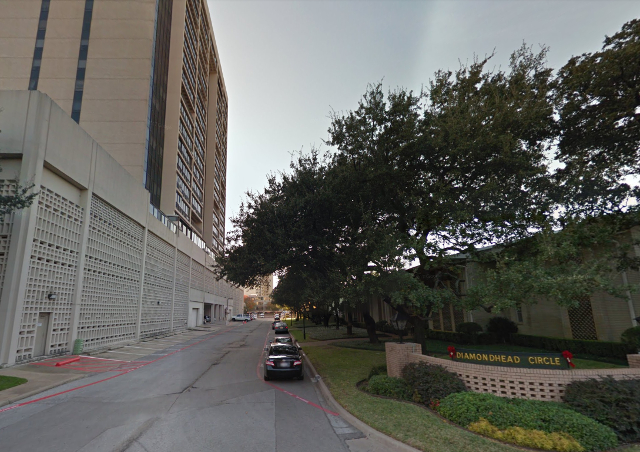
Tower Spacing Ignores an Actual Tower
Before I hit the changes, there’s a big, fat omission on tower spacing (added setbacks between tall buildings). Everyone is so worried about the three parcels in play, they ignored potential redevelopment of Diamond Head Condos directly across Diamond Head Circle from the Athena. The point system allows a developer to “point” their way out of tower spacing on north/south faces. Diamond Head and Athena share an east/west property line … so whew? Not really.
Even before the “points,” the proposed ordinance states
Tower spacing. Along Pickwick Lane, Baltimore Drive, and the interior property lines that run north/south an additional setback of one foot for each two feet in height above 45 feet is required for that portion of a structure over 45 feet in height, up to a total setback of 30 feet.
No mention of the east/west Diamond Head Circle. So the only location where new construction will abut the main face of an existing tower and there’s no tower spacing? WTF?
And this tower spacing isn’t the only setback that forgets the Athena. Within the points system, a developer can “spend” two points to reduce east/west setbacks by 10 feet – pushing a redeveloped Diamond Head even closer to Athena. If the document actually means between Diplomat and Royal Orleans, say it.
Prioritizing Mixed-Income
There are a bunch of after-the-fact, city staff-driven changes, but two impact the viability of redevelopment. The first revolves around mixed-income housing. Both city staff’s original recommendation and the ordinance passed by City Plan Commission essentially allowed developers to pick and choose their poison to increase density above the base 90 units per acre. City staff’s rewrite after City Plan Commission’s approval prioritizes mixed-income housing.
You might be thinking that since a developer would likely max out density bonuses to reach the maximum of 125 units per acre, it doesn’t matter. But it does. Double.
Assuming 125 units per acre regardless, staff’s prioritizing of mixed-income housing between 91 and 115 units per acre results in projects with 20 percent mixed-income. Compare that to Plan Commission’s 8 percent when requiring mixed-income units only between 115 and 125 units per acre.
I recall council members flabbergasted when Lincoln Katy Trail offered an unprecedented 15 percent mixed-income – 20 percent is 5 percent beyond a flabbergast.
City staff is pushing excessive mixed-income on the back of underground parking, diminished building footprints, and perhaps even height (aboveground parking pushes buildings up). Given the near-universal concrete coverage within PD-15, better buildings and streetscapes benefit all.
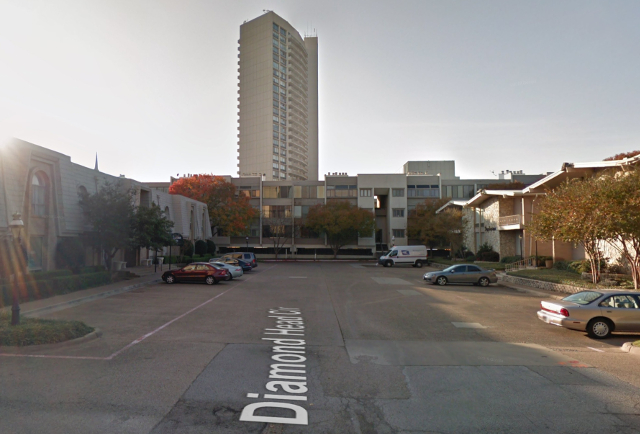
Too Much Green Space?
The second big problem might be excessive green space. Yes, I said it – too much. The bare minimum required is 5 percent, with both plans incenting another 5 percent for five added units per acre.
Plan Commission added room for another 7.5 percent to the 5 percent minimum if Residential Proximity Slope (RPS) was breached, for a total of 12.5 percent connected open space. City staff added the two together to get 17.5 percent open space. Think about a one-acre lot, part of which is eaten up by private roads, sidewalks, and setbacks … now reduce that by 17.5 percent. Not a lot left to build on.
I think city staff pushing such high numbers for open space and mixed-income housing takes enough money out of the equation to put redevelopment in jeopardy.
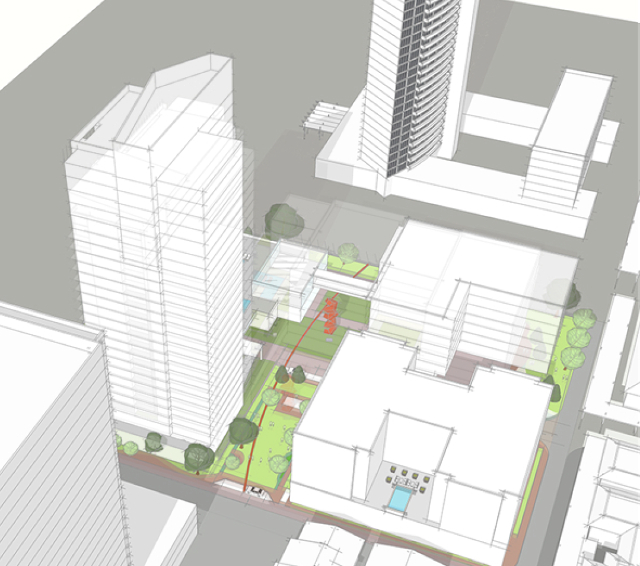
I can hear the towers cheering, but they shouldn’t. I’ve said all along that mutual agreement gets the best outcome. And every time the towers have gone to the mat promoting their NIMBYism, they’ve lost big. Two years ago, there were no Trump tariffs, more/cheaper labor, and a Dallas unconcerned about mixed-income housing. Now all those things are biting into profits. The towers’ unending tantrums have made everything larger. If this set of deals craters, the next set will need even more.
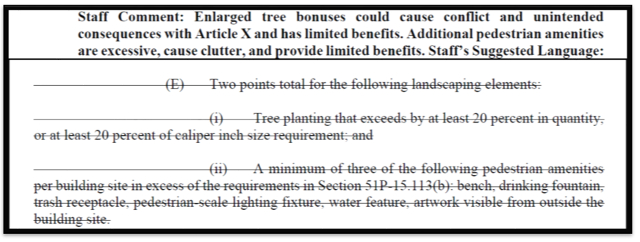
There are other bad insertions by city staff that should be concerning. They advocate for less landscaping because City Plan Commissions’ approved plan would “cause clutter, and provide limited benefits.” Yup, the concrete jungle of PD-15 is in danger of being cluttered in trees.
City staff also wants typical boring Dallas architecture. The City Plan Commission wanted ground-floor units to have fences and stoops, multiple façade materials, and building articulation to make it more interesting than a flat stucco wall. City staff axed it all saying it was covered elsewhere – but it’s not as detailed.

One bite only …
Why is City Staff Taking a Second Bite, Usurping Plan Commission?
My day job requires me to understand complex information and repackage it so that it’s easily understandable and digestible by other groups. My first thought at seeing the latest version was that city staff was repackaging for simplicity. Nope. City staff is changing intent.
It’s a political “we said,” “they said,” “we’re saying again” situation where the intended goal seems to be to sap power from the City Plan Commission and Dallas City Council in favor of the Planning and Zoning department getting the last word.
It’s bureaucrats seeking to supersede elected officials’ will on a high-profile case at a time when there will be seven new members on the Dallas City Council that aren’t sure who to trust. It’s precedent-setting and will have long-felt implications.
As council members consider the final outcome for PD-15, they need to remind themselves that the process has always been that city staff recommends and plan commissioners approve. There are generally no backsies.
I’m reminded of Lincoln Katy Trail, who managed to convince one City Plan Commissioner to ask to reopen their case after failure. The City Plan Commission’s response was a resounding, “what’s done is done,” and that to reopen Pandora’s Box once, opened it to every case they heard.
The Dallas City Council needs to heed that history and thank city staff for their concern and move forward with the PD-15 version approved by the City Plan Commission. There are seven fresh faces at the horseshoe who must work with plan commissioners appointed by their predecessors. To them I say, “Just because you didn’t pick them, doesn’t mean they didn’t do their job.” To believe otherwise weakens the institution of the Dallas City Plan Commission, including for the new members you will soon appoint.
